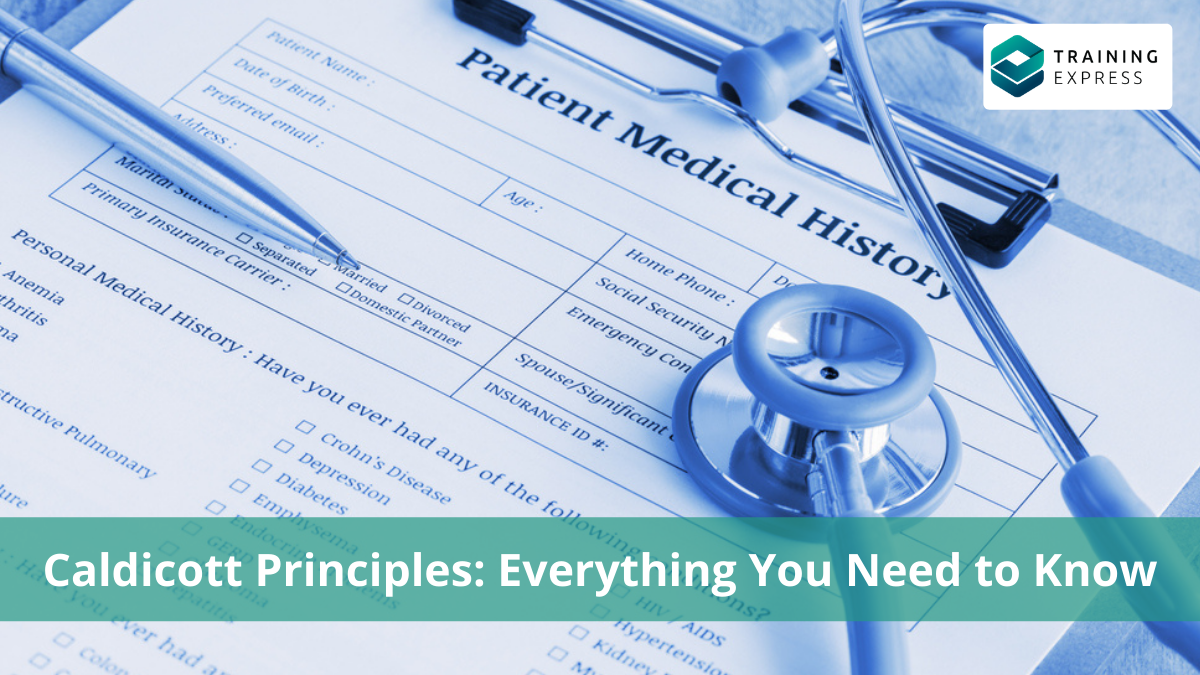
People always value their privacy and protection; it can be a piece of common or confidential information. Although sometimes they are okay with the general thing. They certainly do not want their personal information, such as medical records, to be accessible to anyone at any time.
In 1997, the Caldicott principles were put together to review how the NHS handles patient confidential information. Dame Fiona Caldicott chaired this review. The review results led to the creation of six initial Principles relating to patient personal information. The name of these six principles were Caldicott Principles.
Everyone who works with health and social care should respect and follow these principles. It is necessary to maintain the privacy of a patient for their wellbeing.
Access to health-related data is essential in the fight against the current health situation and COVID-19. But fighting this epidemic should not come at the expense of protecting the patient’s confidential information.
To agree with this, the National Data Guardian (NDG) has considered revising and also expand its Caldicott principles for Health and Social Care. The consultation seeks to clarify the use and access to confidential information in the field of health and social care organizations and patients.
What are the Caldicott Principles?
Because of the raising concerns about the use or misuse of patient’s confidential data, England’s Chief Medical Officer created the Caldicott Principles in 1977. Dame Fiona Caldicott was the head of this review board. The name of the full report is ‘The Caldicott Committee’s Report on the Review of Patient-Identifiable Information’.
The Caldicott Principles are fundamentals that every institute should follow to protect any information that could identify a patient, such as their name and their records. These principles also make sure that the using and sharing of the confidential information at the appropriate time.
Organizations should use these principles as a test to determine when they should share the information or not, that could identify an individual.
There were originally 6 principles, Dame Fiona Caldicott introduced the seventh principle in April 2013 following her second review of information governance. In 2020, the National Data Guardian (NDG) again reviewed these principles and introduced the eighth principle.

The reason behind the introduction of Caldicott Principles
It is extremely important that every institute and industry have an existing and functional set of policies to ensure transparency of its users. Transparency is most important when it comes to health and social care.
The health and social care sectors are essential to the public lives and their wellbeing. These sectors even require further attention due to the personal nature of healthcare, and how they deal with vital information about general people.
For many patients, privacy can play a big role in their healing process, as it helps with how their psyche handles the situation. In the past, a patient’s personal information was easily accessible by the public. Most of the time, leak of personal information put them at the risk of social discrimination and abuse. There are a lot of stories where the rivals acquire a patient’s personal information, especially those in the political sector or leadership position, which was frequent and widespread.
There are several reasons for formulating these principles. Some of them are:
- To make the patient feel more in control of their personal information.
- To protect patient identities.
- To inform the patient how and when to object to the release of their confidential information.
- To make patients feel more confident about their personal information (their personal information is in safe hands, and they do not have to worry).
- To ensure that healthcare personnel do not use personal information if they do not need it.
There was a need for changing the rules about who should have access to the patient’s confidential information. At that time the medical official believes that a set of rules would prohibit unauthorized access to essential and sensitive information. The medical official thought to eliminate this problem and formulate the Caldicott principle.
To supervise the enforcement of the Caldicott principles, senior officials were assign to various related healthcare institutions in the UK. These senior officials ensure that everyone working in social care respects these principles for every patient’s safety and privacy.
How many Caldicott Principles are there?
Now, there are eight Caldicott principles in total after the last review in 2020. The Caldicott principles were initially six until 2013. The founder of the Caldicott principles, Dame Fiona Caldicott, reviewed information governance for the second time in April 2013. She decided it was best to add the seventh principle.
The review started in 2012. She set up a small panel of experts to help her with the review of the Caldicott principle. The study was to make sure that the balance between protecting the patient’s information and the use of that information was appropriate at any given time.
The review recognized that sometimes it is necessary to share patient information for their safety and improved care. In March 2013, the expert panel reached a conclusion that sharing patient information can be as important as the duty to protect patient confidentiality.
In September 2020, the National Data Guardian (NDG) for Health and Social Care has again announced a consultation to make the necessary adjustments on the existing Caldicott principles. The consultation response contains a revised and expanded the Caldicott principles. The outcome of the consultation was that there should be ‘no surprises’ for service users and patients about the use of patients personal information.
The Eight Caldicott Principles
The following are the eight Caldicott principles according to National Data Guardian.
- Justify the purpose(s) for using confidential information.
- Don’t use personal confidential data unless absolutely necessary.
- Use the minimum necessary personal confidential data.
- Access to personal confidential data should be on a strictly need-to-know basis.
- Everyone with access to personal confidential data should be aware of their responsibilities.
- Comply with the law.
- The duty to share information can be as important as the duty to protect patient confidentiality.
- Inform patients and service users about how their confidential information is used.
Keep reading further to learn more about the Caldicott Principles in detail.

Principle 1: Justify the purpose(s) for using confidential information
According to this principle, every proposed use or transfer of patient confidential data within or from an organization should be clearly defined, scrutinized, and documented, with continuing uses regularly reviewed, by an appropriate guardian.
The reasons for sharing any personal information about a patient must be clearly specified. Also, a guardian must be present there for proper documentation and witness if there is further use of patients’ personal information. A patients’ confidential information should only be shared if it is in the best interests of that patient.
Principle 2: Don’t use personal confidential data unless absolutely necessary
Any information that can identify a patient should not be included unless it’s necessary for the specified purpose(s) for which the information is used or accessed. The need to use confidential information of a patient should be considered at each stage of the process.
Before sharing a patient’s confidential information, the healthcare personnel should consider seriously about the patient’s safety. Because sharing any patient personal information can cause a problem in their life safety. One should not necessarily give out confidential information if it is not to protect the patient.
Principle 3: Use the minimum necessary personal confidential data
The third principle is that personally identifiable information can be used when it is absolutely necessary and each item should be considered and justified. This ensures that a minimum amount of data is shared and the probability of patient identification is also minimal.
Give out personal information of any patient where it is necessary, only the most important and least personal data should be shared. Patient personal data should be checked and considered before sharing it to protect patient confidentiality.
Principle 4: Access to personal confidential data should be on a strictly need-to-know basis
Access to patient personal confidential information should be allowed only to those people who are permitted from the institute. Personal confidential data isn’t meant to be visible to anybody and everybody, so health or social professionals must strictly follow this fourth principle. They should see only the confidential items that they need to see.
Individuals or organizations may seek or request permission to access data, or they may ask to share data with them. It is the responsibility of the health or social worker to ensure that unauthorized personnel do not get the access. Personal confidential information will always remain confidential to those who should not have access to it.
Principle 5: Everyone with access to personal confidential data should be aware of their responsibilities
Very few people should be allowed access to a patient’s personal confidential data. These few people who are privy to such information should take note of their responsibilities and duties in making sure they protect the interest of the patient. An unauthorized person or organization must not have access to such information.
Necessary steps should be taken to ensure that people who are allowed access to these personal confidential information are aware of their obligation. They must respect and honour the client’s privacy.
Health and social workers should not give confidential information about any patient in any circumstances. Also, if personal information needs to be shared, it must be in the best interest of the patient or those who are officially allowed to access the data.
Principle 6: Comply with the law
The sixth principle of Caldicott states that every use of confidential information must be lawful. Every organization that has confidential information should have at least one person who is in charge of ensuring that all legal requirements are followed.
A social or health organization will not want to disclose any confidential information of a person carelessly. The laws are there for anyone to read and understand, if anyone violates such laws there can be legal consequences.
All these personnel who handle confidential information are responsible for ensuring that their use of and access to that information complies with law.
Principle 7: The duty to share information can be important as the duty to protect patient confidentiality
There comes a time when it is necessary to share some information about a patient. In such cases, health or social care professionals will be forced to share some information about a patient. Health or social care professionals should be supported by the policies of their employers, regulators and professional bodies.
Sometimes, government agencies or research and development organizations may need information for other purposes. In such cases, they should share a patient’s personal information but must ensure that the patient is anonymous.
Principle 8: Inform patients and service users about how their confidential information is used
The eighth principle of Caldicott states that the authority should take a range of steps to make sure the patients and service users are well-informed and there are no surprises. They have a clear idea about how and why their confidential information is used, and what choices they have about this. These steps will vary depending on the use: as a minimum, this should include providing accessible, relevant and appropriate information – in some cases, greater engagement will be required.
However, they must ensure that it is done within the framework set out by these principles, and not outside what the policies provide. They must oversee the flow of patient information either for research, or disclosure of information to the police.

How do the Caldicott Principles Apply to your Setting?
Caldicott principles are the basic rules and regulations that ensure a patient’s confidentiality. These basic rules every healthcare personnel must follow to ensure there is no breach of confidentiality.
Dame Fiona Caldicott put together the first sixth Caldicott principles in 1997. In April 2013, she added another principle. In 2020 the National Data Guardian (NDG) again reviewed these principles and added the eighth principle.
As explained above, Caldicott principles are important. because patients’ confidentiality needs to be protected. However, there has been confusion over this, whether it would be fair or not to provide personal information about patients.
The healthcare personnel can share personal identification information of a patient, if:
- The patient is transferred to another hospital or facility for treatment.
- Don’t use personal confidential data unless absolutely necessary.
- Use the minimum necessary personal confidential data.
- Access to personal confidential data should be on a strictly need-to-know basis.
- Everyone with access to personal confidential data should be aware of their responsibilities.
There was a need for changing the rules about who should have access to the patient’s confidential information. At that time the medical official believes that a set of rules would prohibit unauthorized access to essential and sensitive information. The medical official thought to eliminate this problem and formulate the Caldicott principle.
To supervise the enforcement of the Caldicott principles, senior officials were assign to various related healthcare institutions in the UK. These senior officials ensure that everyone working in social care respects these principles for every patient’s safety and privacy.
Designated Safeguarding Lead - Essential Skills
Designated Safeguarding Lead - Essential Skills
Closing Note
The introduction of the Caldicott principles in the healthcare sector was the right move in the right direction. Because these principles brought better policies in the health care sector.
Nowadays, there are more standard solutions and tools to improve the healthcare sector and protect the sensitive and personal information of patients.
An institution that works with these policies will notice a clear difference in their operations and managing patients. With the recent addition of the eighth principle, we now know-how and who are using our information.
Want to know more about how to protect patients confidential information and the Caldicott Principle, take an online course with Training Express.
Read more on our blog
- The Early Years Foundation Stage (EYFS)
- Sports First Aid | Everything You Need To Know
- Lots of Likes on Instagram: How You Can Quickly Increase Popularity
- Why You Should Use Photo Background Removers For Mobile Devices
- Maximizing ROI: 11 Strategies For Efficient Advertising Spend
- How to Keep Your Data Safe While Applying for Jobs: 6 Tips
- Take Mac Classes to Transform Your Design Profession
- Exploring the landscape of e-commerce hosting
- Personal Branding For Executives: 7 Tips For Maximum Impact
- Transformative Technologies in Senior Living Homes: A Glimpse into 2024
- Available Courses
- Career Bundles73
- Animal care5
- Law8
- Quality Licence Scheme Endorsed111
- Teaching13
- Teaching & Academics Primary27
- Accounting & Finance Primary30
- Training3
- Design9
- IT & Software44
- Healthcare126
- Marketing31
- Health and Safety402
- Construction48
- Electronics25
- Hospitality22
- Health and Social Care219
- Child Psychology37
- Management377
- Business Skills268
- First Aid70
- Employability264
- Safeguarding75
- Food Hygiene103
- Personal Development1277
 Food Hygiene
Food Hygiene Health & Safety
Health & Safety Safeguarding
Safeguarding First Aid
First Aid Business Skills
Business Skills Personal Development
Personal Development







